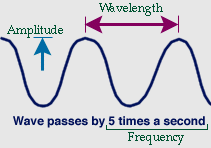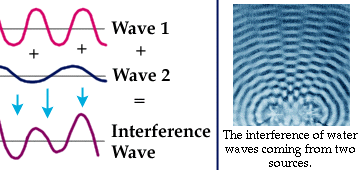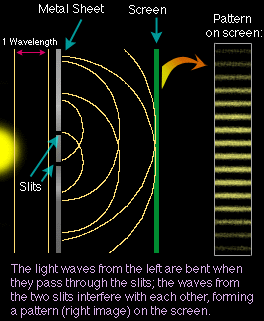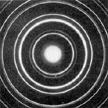 The strength of the vibration is the amplitude.
The strength of the vibration is the amplitude.
 The strength of the vibration is the amplitude.
The strength of the vibration is the amplitude.

There are many more wave properties we can't get into for lack of space.

Imagine a light source being blocked by a sheet of metal with two slits in it. A few meters away there is a screen. For a given point along the screen, there are two light waves hitting the screen (one through each hole). These two light waves travel different distances to reach the screen, so they interfere with each other, creating an interference pattern.
It turns out that if you repeat the same experiment using a particle beam instead of a light source, you record a similar interference pattern. This means that all particles have wave properties. For example, here's a real interference pattern caused by an electrons scattering off gold foil:
 It is a very strange concept that
what we think of as solid matter particles are,
in reality, wave-like because matter
particles have frequency, wavelength, and
can interfere with each other.
It is important to note that sub-atomic
particles' wavelengths are not due to the particles
"jiggling" around; rather, the particles' properties phase in and out.
For example, a light particle (the photon) is a
wave because its electromagnetic field phases from one sign to the other.
It is a very strange concept that
what we think of as solid matter particles are,
in reality, wave-like because matter
particles have frequency, wavelength, and
can interfere with each other.
It is important to note that sub-atomic
particles' wavelengths are not due to the particles
"jiggling" around; rather, the particles' properties phase in and out.
For example, a light particle (the photon) is a
wave because its electromagnetic field phases from one sign to the other.